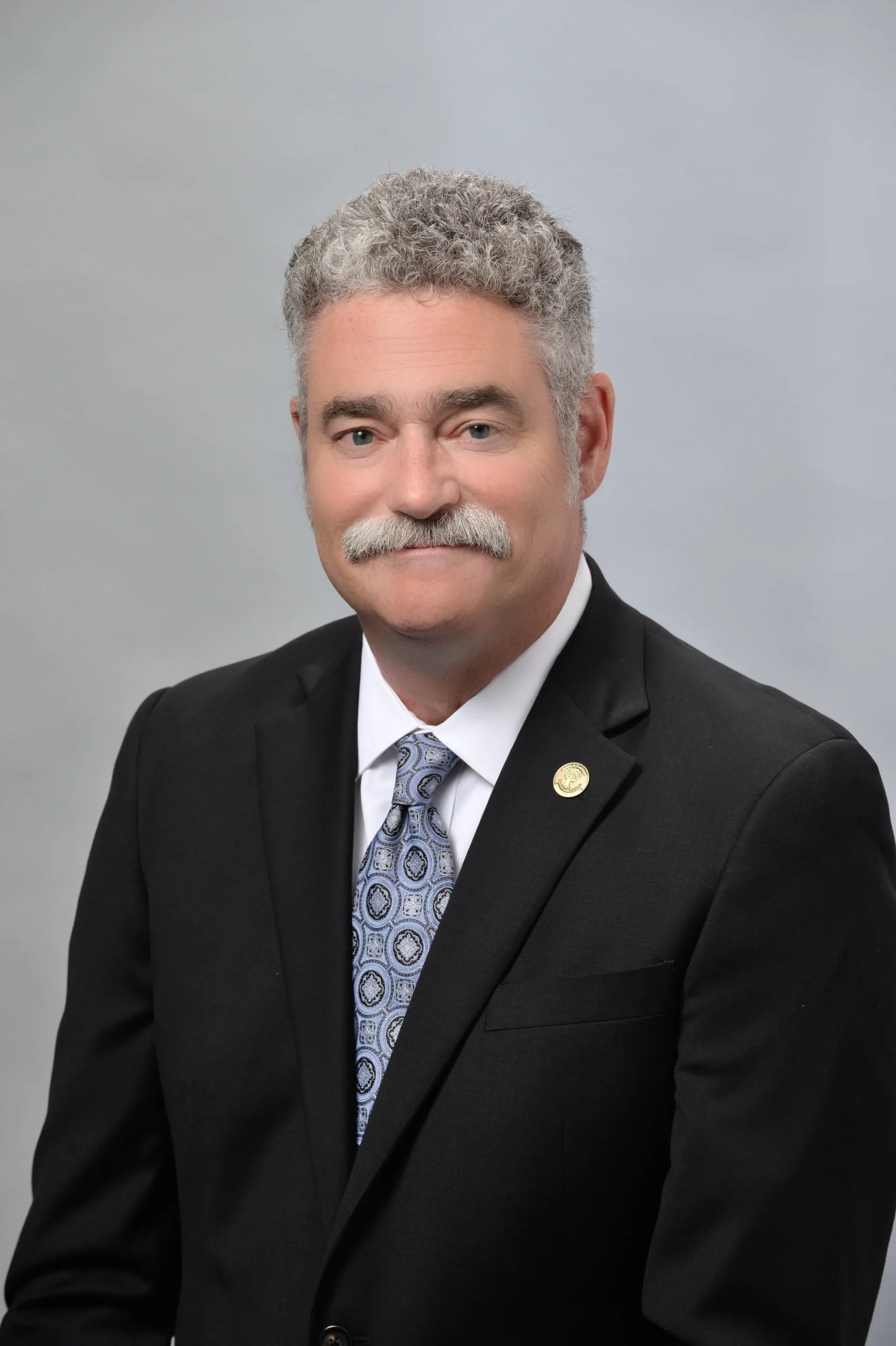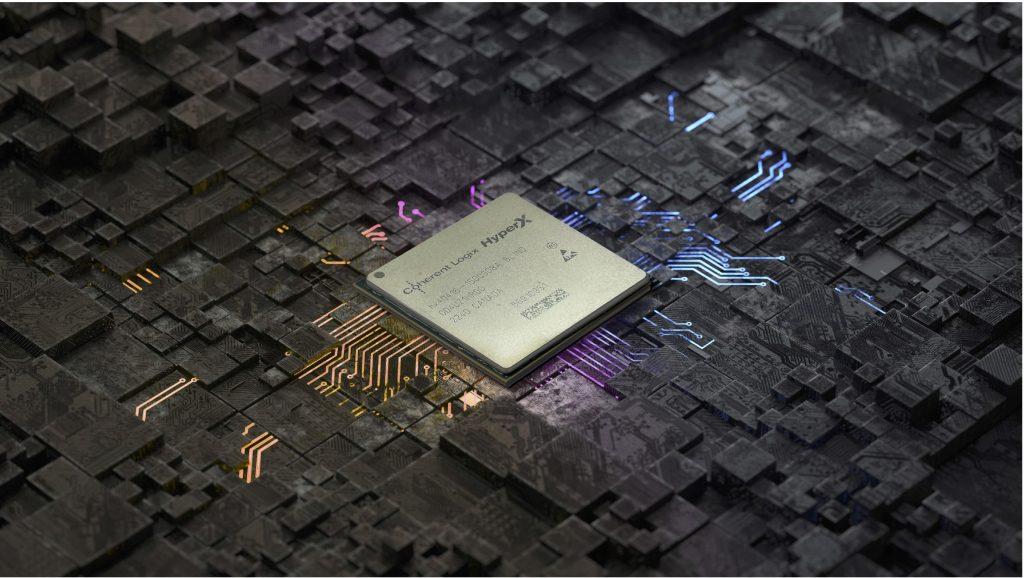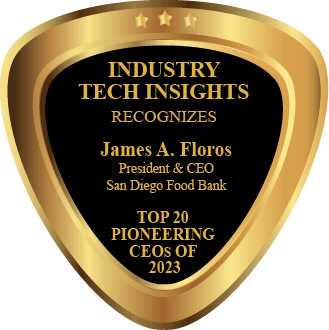
- December 27, 2025 12:21 pm
- California

One of the things that set James A. Floros, President & CEO, Jacobs & Cushman San Diego Food Bank aside from other nonprofit CEOs is that he has always run a nonprofit like a business. “The efficiency and effectiveness that is required in the for-profit sector is even more important in the nonprofit sector because you are doing more with less, with less staff and less resources,” he explains. “Three to four weeks into the pandemic, I realized how well our organization was doing and I realized it was because of the work we had done in building an organization based on excellence.” They have an outstanding relationship with their donors, with media, elected officials, have top-notch financials, with 94 cents of every dollar going directly to our programs and services, and an amazing culture among the staff and volunteers.
Founded in 1977, the San Diego Food Bank was an organization that only prearranged food drives and food distributions around the holidays. In years after that, the organization realized that food insecurity was a yearlong problem and challenge, and so they began working toward building an organization that would serve the community throughout the year. Food insecurity was still something that many did not realize was a major drain in society. As food banks have grown and become more sophisticated, and links between food insecurity leading to poor academic performance and poor health outcomes became known, food banks then became an essential part of any community’s ability to work to end the cycle of poverty.
“There is a misconception people have about who is served by a food bank. Generally, people think food banks are solely feeding the homeless or those on government assistance. Nothing can be further from the truth,” says James. “Our service population is the working poor, seniors on fixed incomes, children living in poverty and very surprisingly low-income active-duty military families. People all around us are food insecure.” He explains, “people all around us are not reaching their full potential because they are not getting enough nutritious food. If people do not have access to nutritious food, they are more likely to repeat and be stuck in the cycle of poverty.”
A few strengths built into the organization are to be adaptable, know when to pivot, and find a way to overcome any challenge. That was already in their DNA before the pandemic, but that has served them so well throughout these challenging times. “We have seen new problems rise and we have been very quick to change course as needed. We are entering Phase 4 of our COVID response, which means there were three phases beforehand that are perfect examples of how we successfully adapted, pivoted and overcame these unprecedented times,” says James.
The San Diego Food Bank and their North County Food Bank chapter are supply chains at their very best. While they do not prepare meals, that is something that their nonprofit partners would do, what they are doing is distributing essential food items to those that come to distributions. “We do that through 200 direct distributions that we directly oversee. There are over 200 of those each month throughout the county plus, and perhaps one of the best aspects of the San Diego Food Bank and many people do not know this, we have partnerships with more than 500 nonprofits throughout the San Diego region,” explains James. “Any nonprofit that has a feeding program in our county, more likely than not, gets the majority of their food from us. This makes us one of the most grassroots nonprofits in San Diego County.” Their partnerships—an integral part of their success—range from well-known agencies like Catholic Charities and the Salvation Army to smaller church pantries.
San Diego Food Bank’s mission is to provide nutritious food to those in need, so their focus was that and not on becoming an environmentally sensitive organization. However, they discovered that if they were more environmentally conscious, they could save more money, which meant San Diego Food Bank could provide more food to people in need. “We began with 1,400 solar panels, which saves us $120,000 a year, which is the equivalent to about 600,000 meals. We worked with San Diego Gas & Electric for our climate control and lighting,” says James. “Installing phase change material in our freezers, which allows us to turn our compressors off at 7 p.m. at night and not turn it on until the next morning, saves energy, and saves us money.” Their Composting and Recycling Center features a “Turbo Separator.” This machine helps them separate expired food products from their packaging, and the packaging is then recycled, and the food waste is turned into compost. “We were the first food bank in the world to receive LEED v4 Gold Status. And in 2020, we received the City of San Diego’s Business Waste Reduction and Recycling Award. We consider ourselves a zero-waste facility and last year we diverted over 1 million pounds from the landfill,” he adds.
The San Diego Food Bank was feeding 350,000 people before the pandemic; since then, they have almost doubled that amount and are now feeding about 600,000 people a month. This number includes the regular service population that they served before the pandemic, many of them seniors. “We have also made it easier for people to receive food with client dignity. We have invested in what we call “Capacity Grants” to our nonprofit’s partners, which is strengthening their ability to meet the surge in demand, helping them build their resources with pallet jacks, refrigerators, trucks and more,” adds James. “By supporting our partner agencies become more effective, it helps us meet the increased demand amongst our service population. We want to focus on being more than just a food bank; we want to focus on being a nutrition bank.” According to James, “Most notably the Food 4 Kids Backpack program, the feedback we are getting from schools is incredible. Students do not have to worry about where their next meal will come from and can focus on school. We see less absenteeism and students’ grades have improved since being on the program.”

The Unique Solutions
The company offers powerful Systems on Chips (SoCs) and a software suite for creating customized solutions. And the current flagship is HyperX Midnight, a radiation-hardened supercomputer class SoC designed for use in LEO, MEO, and GEO (low-, middle-, and geosynchronous earth orbit) satellites.
HyperX Midnight, soon after its release, became the most advanced space processor available, with roughly four times the computing throughput at half the power demand of competitive chips.
“This is a significant step, as performance and power consumption control the magnitude of a satellite. We put enormous performance in a small package with low power obligations, so our customers can use much smaller satellite busses (chassis) which conserves millions in launch budgets,” says Walt. Another key feature of Coherent’s HyperX multi-chip modules compared to its competitors is that its chips are C-programmable and use familiar tools and debugging processes. “The solutions can be built on our chip in about 6 months whereas competitive FPGA offerings usually require 24 months of development time using complex hardware development languages and a very difficult process called timing closure,” he adds.
Coherent Logix’s SoCs are also completely reprogrammable, even in space, and can modify tasks in less than 50ns (nanoseconds). These two elements combine to create a huge advantage. Coherent Logix can make four products in the time our competitors take to build just one, and we can continuously enhance those products even if they are in orbit around the Earth.
These attributes herald back to Coherent Logix’s patented invention: the HyperX fabric. And this fabric is common to all Coherent Logix’ chips – both Space-qualified and terrestrial – so these advantages are available whether users are building a satellite, 5G cellular, secure networks, AI platforms, or 8K video encoders. Coherent Logix has served the Space 2.0 and Defense markets for 15 years. High-performance computing (HPC) with low power draw, on-orbit programmability, and ease of modular multimodal MCM design are the keys to success in these markets according to Walt.
The Leader who Makes the Difference
Walt Gall, Ph.D. serves as CEO on Coherent Logix’s executive management team. He is a business leader who builds world-class AI teams, products, and strategic partnerships for top-tier start-ups (Saffron, Intel acquisition) and large corporations (Amazon Devices, Meta (formerly FB).
As CEO of Coherent Logix, the leader in low-power, high-performance C- programmable processors for the embedded systems market, he recently helped guide the company through a funding initiative that raised $85 million.
Under Walt’s leadership, in early 2023 Coherent Logix launched HyperX Midnight, the world’s most advanced space processor, with roughly four times the computing throughput at half the power demand of competitive chips. Coherent Logix is currently in its fourth generation of HyperX processors for Space 2.0 and Defense, Connected Devices, and Media & Communications industries. The company has been granted more than 375 patents and 125 patents are pending.
Over the past decade, Walt has held various leadership roles on executive teams, including Amazon Alexa AI, Meta’s AR/VR and AI divisions, and Intel AI, with responsibilities for annual operational planning, developing a 3-year strategy, and managing more than $500M R&D and production budgets. He led product launches on conversational AI voice assistants on industry-leading consumer and social media devices with cloud-to-edge embedded applications and the development of several enterprise decision-support AI/IOT solutions in wellness, health, hi-tech, and insurance sectors.
Walt’s leadership style is centered on the customer and making data-informed, timely decisions. This customer-centric team approach is critical as the company scales its products and continues to expand its channel partnerships. “I’m referring to our direct customers and strategic partners, our leadership team and employees, and our Board of Directors,” he adds. “We have a collective interest in growing revenue and partnering on developing and commercializing products that have a meaningful impact on society.”
Armed with this mindset, Walt and the rest of the leadership team have skillfully guided Coherent Logix into hypergrowth markets: Space 2.0, cybersecurity, connected devices, media and communications.

Towards the Future
Coherent Logix is adding a cloud-based capability for new customers, universities, and the Maker/open-source community to work with their development tools and hardware. With older von Neumann microprocessor architecture designs and today’s programmable hardware, the software development process is so tedious that it can take 24-36 months for a customer to develop a solution e.g., a WiFi router. Coherent Logix microprocessors, however, have C-programmability and use standard software development processes. They also offer a cycle-accurate simulation platform. These advantages enable Coherent Logix to build solutions in just six months and continue to reprogram or reconfigure as needed to support their product and customer roadmaps with new software-defined functions or as standards evolve. This, combined with the hardware/software co-design process the company uses to build their System on Chips (SoCs), brings the power of digital transformation to the design and use of digital processors – amplifying both the pace of innovation and the competitive advantages of Coherent Logix.
For the near future, Walt is striving towards building highly functioning, distributed teams to bring the most disruptive products to market he has worked on, i.e., a new class of low-power, reprogrammable, high-performance computing devices. Coherent Logix is enabling customers to “redefine hardware as software” (which is also the company’s tagline) to meet the market demand for the flexibility, extensibility, and scalability of software-defined hardware systems and their small SWaP requirements, ranging from space satellites to consumer devices. Coherent Logix’s HyperX architecture provides a paradigm shift in hardware-software co-design from embedded systems to the cloud and delivers a more cost-effective and scalable software-defined device strategy. With its compute and memory co-localized, an event-oriented, parallel processing fabric, low power profile, and C-programmability, this has a 2-4x improvement in the time it takes to develop and launch products. This multi-faceted value proposition extends product customer lifetime value economic models, increasing the ROI for its ODM and OEM partners and customers. Accomplishing these product revenue growths and customer-centric goals will lead naturally to the longer-term goal of positioning Coherent Logix for a successful market exit for its shareholders.
“The future requires low-power, high performance computing for next generation connected devices – it will be everywhere we find a sensor, a camera, a robot, or smart device. As large as the Space 2.0 revolution is, the terrestrial edge and embedded devices will eclipse it by orders of magnitude,” concludes Walt. “We must be as efficient with power as possible. It has a cost to our planet to produce, and it turns into heat when you use it. If we want to preserve our planet, smart everything must become smart, efficient everything.”

" We want to focus on being more than just a food bank; we want to focus on being a nutrition bank. "
James A. Floros
President & CEO